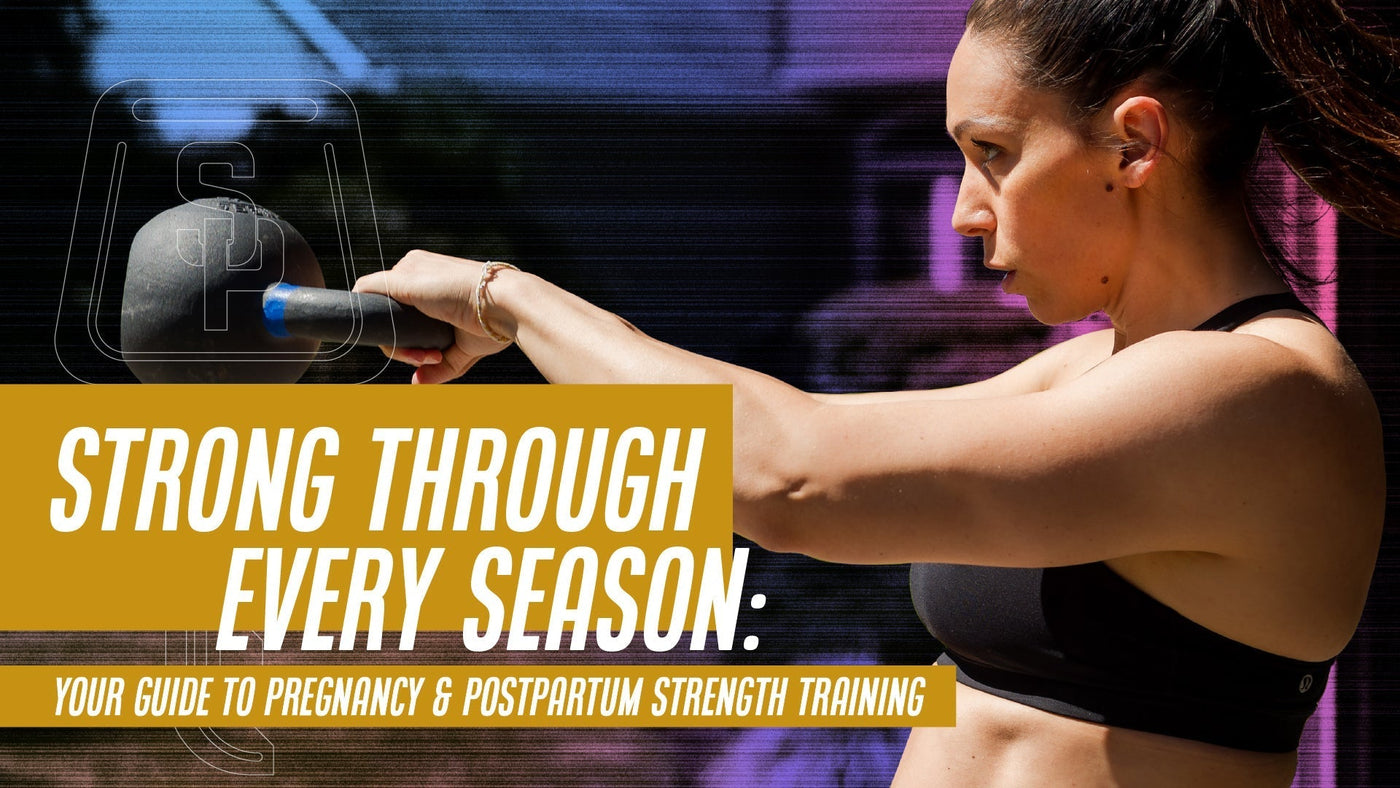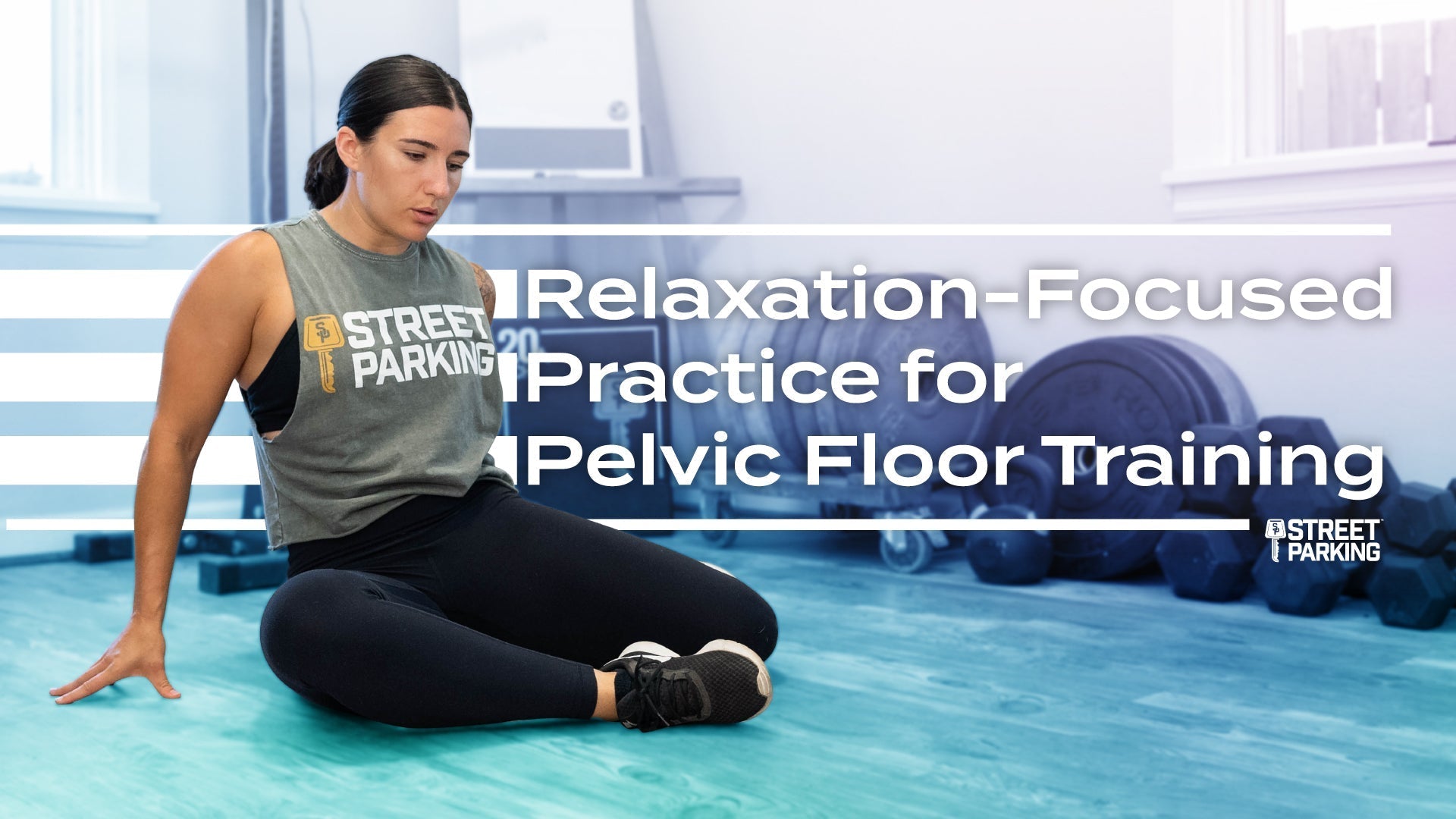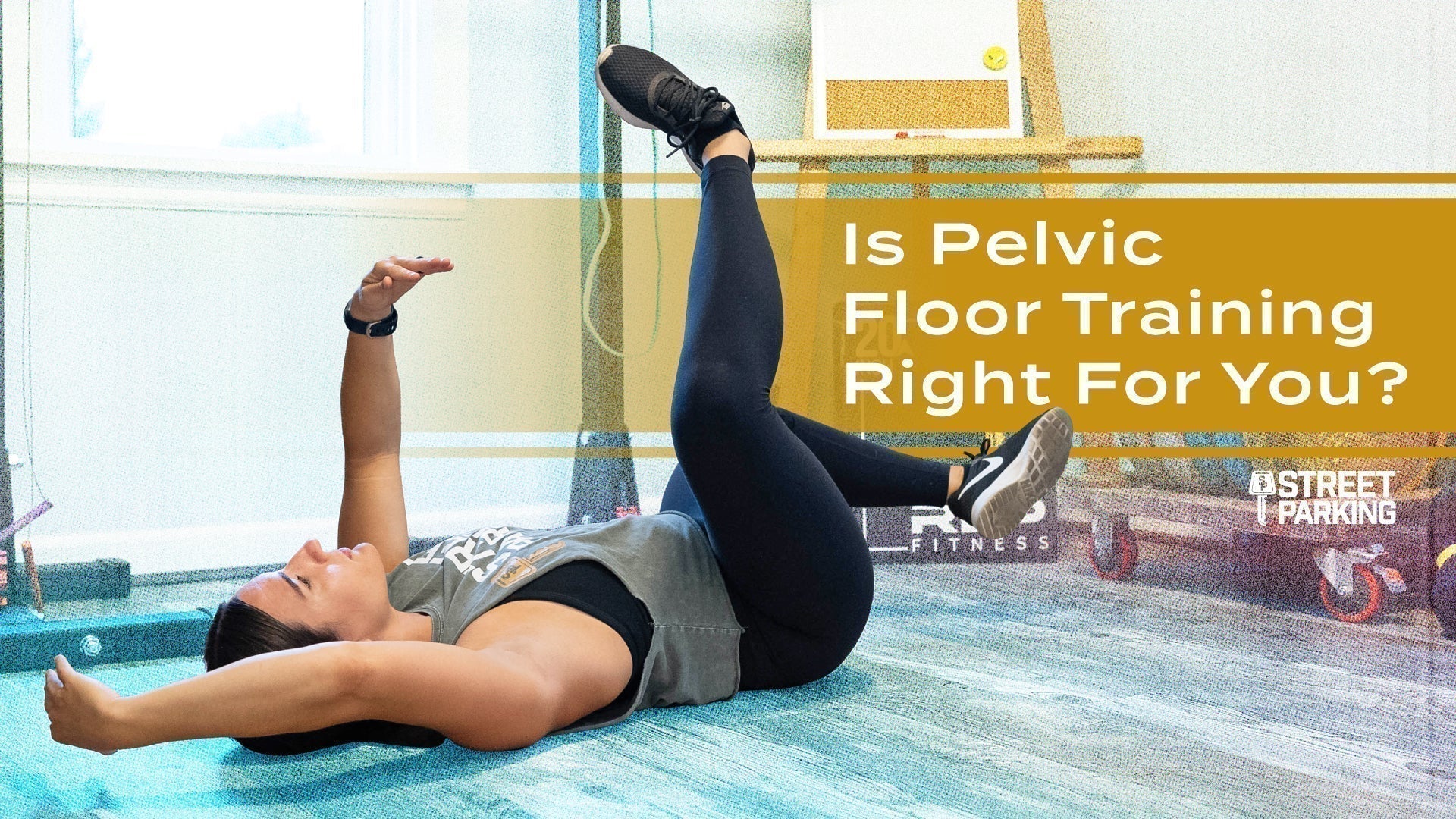
"You shouldn't lift heavy while pregnant."
"Stick to yoga and walking – it’s safer."
“Don’t brace or breath hold when you lift weights in pregnancy.”
"Don't do any exercise until you're cleared at your 6 week postpartum appointment."
“Everything looks great—you’re cleared to resume all normal activities, including exercise."- at the 6 week appointment.
If you're pregnant or postpartum, you've heard this outdated advice. The fitness world has an endless list of "don'ts" for expecting and new moms. But the latest science tells us strength training isn't just safe during pregnancy and postpartum—it's beneficial.
Our goal is to help you find ways to continue to move and train consistently – as fitness and specifically strength training has tremendous value physically and mentally for you, your birth, recovery, and beyond.
The key isn't following a rigid program or accepting limitations. It's about finding freedom in fitness and listening to your body. This guide will help you navigate your strength journey with confidence, supported by current research and real-world experience, whether you're a seasoned lifter or new to training.
In this article we’ll explore:
Why Strength Training Matters
Strength training during pregnancy isn't just about immediate benefits—it's an investment in your postpartum recovery. Here's how it supports you:
- Core & Pelvic Floor Health: Recent research shows that strength work reduces postpartum ab separation (Diastasis Rectus Abdominus) and pelvic floor dysfunction. A strong core also helps manage pregnancy's postural changes.
- Birth Preparation: While birth experiences vary widely, strength training improves overall endurance and stamina. Focus on preparing your body while staying informed about all birthing options.
- Pain Management: Strategic hip, glute, and core work can reduce common pregnancy discomforts like back and pelvic pain. Need help? Check our Pelvic Pain Blog Series.
-
Physical Health: Regular strength training is linked to:
- Improved energy levels (varying by individual)
- Faster postpartum recovery
- Reduced risk of gestational diabetes and pre-eclampsia
- Mental Health: Just 80 minutes of moderate exercise weekly (15 minutes, 5x/week) can reduce the risk and severity of postpartum depression and anxiety, according to new research.
Before we dive into the specifics, let's talk about setting yourself up for success. Every strong foundation needs a solid support system.
Medical Team Collaboration
- During pregnancy: Have an open dialogue with your healthcare provider about your strength training plans. Bring specific questions about your routine and any concerns.
-
Postpartum: Remember that recovery isn't linear. Your return-to-exercise timeline should be personalized based on:
- Your birth experience
- Recovery progress
- Energy levels and sleep quality
- Overall life demands (work, other children, etc.)
- Previous training experience
- Specific goals (whether that's general fitness or returning to competitive sports)
Professional Support
- Consider working with a pelvic floor physical therapist (especially if you're experiencing any discomfort or concerns)
- Street Parking's Pregnancy and PP Coaches are here to help customize your approach
Now let’s get into the how and a generalized approach on how to utilize strength training as a pregnant or postpartum athlete!
How to Strength Train Safely
The Mindset Shift
Think of this as your strategic "deload season." Just like elite athletes use deload periods to build long-term success, you're investing in your future strength. This isn't about limitations—it's about smart training, so shifting your mindset is the first step.
In this section we’ll cover:
- Stages & Intensity
- Foundational Movements
- Movement at various stages
Stages & Intensity
Your approach to strength training, your focus and the intensity of your training will depend on your starting point. Let's break it down:
New to Strength Training?
Pregnancy
- Focus on foundational movements with bodyweight or light weights
- Focus on developing technique and range of motion (as you’re able)
- Focus on intentional movement, going slower or adding additional rest between movements as needed
- Focus on developing confidence in lifting – rather than focusing on load (heavier weight with fewer reps) consider lighter weight with higher reps
- Building a strong foundation now sets you up for long-term success
🔑Recommended Street Parking Programs: SHIFT Daily Workouts, Dumbbell Strength Series
Postpartum
- Focus on learning technique, developing confidence, and working on finding your range of motion.
- Start with light weights similar to what you would use for activities of daily living (the carseat as an example!)
- Building a solid foundation in the postpartum recovery period is a key bridge to our other programs and your long-term goals.
🔑Recommended Street Parking Programs: 4th Trimester Bundle (or similar Recovery, Rehab and Rebuild programs) to intentionally and progressively build strength and coordination for your core, glutes, hips and pelvic floor
Experienced Lifter?
Pregnancy
You can generally maintain (heavy) resistance training with some individualized modifications.*
- We advise pausing going for PRs in pregnancy (for most individuals)
- For heavy lifts requiring breath hold: stay at or below 90% of your 10RM
- Try to have at least 3-4 reps in reserve for most lifts
- Focus on quality movement over maximum weight (only work within your technical ability, we aren’t trying to grind out reps to just try and get a rep)
- Add in additional rest between sets as needed
- Weigh your individual risk vs. reward of performing a movement by asking “how will this help support me right now and into my postpartum recovery?”
🔑 Recommended Street Parking Programs: Dumbbell Strength Programs or the Butts & Guts Programs to help focus on unilateral strength
*The latest research supports continuing to lift heavier when appropriate and based on your own individual goals, experience, and symptoms. Check out this research publication.
Postpartum
- There is a saying: Slow is smooth and smooth is fast… approach your postpartum recovery with this macro lens!
- Focus on redeveloping coordination and range of motion, assessing for any new symptoms you could experience
- Focus on technique, especially for olympic weightlifting or power lifting, as well as help prepare for return to running
- Gradually add load as you return to regular programming
🔑Recommended Street Parking Programs: 4th Trimester Bundle (or similar Recovery, Rehab and Rebuild programs); Dumbbell Strength Series to help mitigate strength imbalances.
Foundational Movements & Programs to Consider
Functional movement patterns (squat, hinge, lunge, push, pull, carry) form the backbone of your training and are adaptable for all stages. Often, a slight adjustment or customization makes all the difference. Use this season to explore movement and as an opportunity to build strength in new ways!
Warm Ups and/or Recovery Days:
-
Use the SP Functional Progression Warmups. This is beneficial for both pregnancy and postpartum recovery.
*The shown exercises for the movement patterns are not black and white and are only general examples of movements that could be utilized*
Lower Body
- Squat: Front, Back, Goblet, Box/Target
- Hinge: Deadlifts, Bridges
- Unilateral movement: Lunges, Step Ups, Bridge Variations modified as needed such as staggered stance, lateral and supported variations can be really helpful especially if you have pelvic pain.
🔑Recommended Street Parking Programs: Dumbbell Strength Series, Butts and Guts Series
Upper Body
- Push: shoulder press, horizontal push like bench or pushups, landmine, etc
- Pull: row variations
- Accessory: Bicep curls, Lateral raises, etc.
🔑Recommended Street Parking Programs: Suns Out Guns Out, Mamas Suns Out Guns Out Program
Core
Anti Rotational
- Carries/Marches
- Holds
- Pallof Presses
- Planks/Side planks (modify to elevated, bent knee supported for side plank)
- Bird Dogs (modified)
Rotational
- Woodchoppers (variations)
- Standing pallof press with rotation
- Med Ball Rotational Throws
🔑 As a part of your prehab or rehab, consider adding 1-3 core movements into your warmup, like side planks and pallof presses to focus on breath work and stability or use variations/customizations for more traditional core movements in our daily workouts!
Pelvic floor downtraining: (aka learning to relax tension in your pelvic floor)
- In Pregnancy, focus on downtraining your pelvic floor muscles as you near your delivery date to help prep for labor!
- Downtrain if you have pelvic pain to help calm symptoms down
- Check this video out for a short routine you can add in after workouts or on your recovery days!
- Be aware: kegels are OKAY despite what may be shared on social media. The best way to know if kegel or downtraining is appropriate for you is by visiting with a pelvic health professional or checking in with one of the SP Pregnancy and PP Coaches!
Additional Street Parking Programming Resources
- For both phases: Functional Progression Warmups (SP Members Only > Mamas > Warmups) as a part of your warmup or recovery day
- “Mamas Modifications” included in all daily programming for customization ideas
Movement At Various Stages: Customization is Key
Every day might feel different, and that's perfectly normal. The key to long-term success is responding to your body's signals rather than pushing through them. Think of modifications not as "scaling back" but as "training to meet yourself where you are." Your body is doing incredible things—let's work with it, not against it.
During Pregnancy
Your body changes week by week, and your training should adapt accordingly:
| Load Management |
| 1st trimester: Often business as usual |
| 2nd trimester: Begin adjusting based on goals, symptoms (ex: Barbell snatch adjusting to Overhead Squats, Snatch Grip Deadlift, DB Snatches) |
| 3rd trimester: Expect to decrease weights gradually and adjust range of motion (ex: adjust overhead press to landmine press) |
| Key principle: Quality movement > Heavy loads |
Postpartum Return
Your next season starts here— this is an opportunity to rebuild strength and coordination and set the foundation for everything ahead. It’s tempting to rush, but think of it as playing the long game—small, consistent wins now will set you up for lasting strength and success!
| The Build-Back Framework |
| 0-3 months postpartum: Start with rehab and rebuild work (covered in our 4th Trimester Bundle) This is a focus on building to full range of motion, working with lighter weights and rebuilding confidence (additional ex: loads lifting might be similar to activities of daily living, barbell only focusing on technique, 50% of your 10RM, etc) Reminder: Recovery is a FREE program for all Street Parking members that begins to introduce gentle movement for the first 0-6 weeks postpartum. |
| 3-6 months postpartum: Progressively introducing increased load, volume and intensity via programs like 20 Rep Squat, Power 30, Oly EMOM, 5/3/1- start with a barbell only for most people and can start exploring breath hold strategies depending on recovery. (More on breathing strategies below) |
| 6-9 months postpartum: Building speed/intensity and continuing to increase load based on recovery and goals. Many people may around this time start to feel more like their pre-pregnancy selves. Reintroducing valsalva (breath hold) if appropriate as well as weight belts (quick note: we recommend holding off on weight belts to ensure you have built the core strength and coordination to manage pressure/stamina for lifting heavier loads!) |
| 9+ months postpartum: same as above in regards to progressively building load as tolerated and based on individual goals like returning to competition, hitting PRs, etc. |
Training Strategies and Adjustments
Every pregnant and postpartum athlete can benefit from customizing their strength training program. While specific movement modifications are helpful, mastering fundamental strategies—like breathing, tension, bracing, and positioning—can transform your training experience and support both performance and pelvic floor health. These strategies serve as your toolkit, helping you navigate symptoms and discover what works best for your body at each stage.
Overall Strategies:
- Adjust load as needed
- Adjust reps/volume as needed
- Adjust intensity as needed. Often in pregnancy this means reducing as you get closer to your delivery date, and in postpartum it means gradually rebuilding after you’ve rebuilt a foundation of strength and coordination!
Breathing
There’s no one-size-fits-all approach to breathing. Here are a few effective techniques:
- Exhale on Exertion – Exhale during the hardest part of the movement.
- → Example: Exhale as you rise from the bottom of a squat.
- Exhale Through Full Range of Motion – Inhale 360° at the start, then exhale continuously throughout the movement.
- → Example: Inhale at the top of a barbell back squat, then exhale through both the lowering (eccentric) and lifting (concentric) phases.
- Breath Hold (For Heavier Lifts, Build Up Postpartum) – Inhale 360°, release a small exhale, brace as if preparing for impact, then hold through the full range of motion.
- → Example: Inhale, brace, and hold during a heavy deadlift.
🔑 Check out the Breath Strategy Video for more techniques!
All strategies are valid, but postpartum athletes should rebuild core control first before progressing to advanced bracing techniques.
Position
- Adjust your range of motion, your stance, your grip, your torso position as you need to
- → Example- conventional deadlift position to sumo deadlift position
- Aim to have torso stacked over pelvis in most movements
- → Example- in the deadlift, watch for the hips shooting forward at the top of the repetition. Focus on ending standing tall in a stacked ribs over hips position.
🔑 Watch the Position Strategy Video for more tips!
Tension
- Dial up or dial down the amount of tension needed to perform a lift
- → Example: more tension will generally be needed for a barbell back squat versus an air squat
- Athletes are often taught to squeeze everything as hard as possible which is not always efficient and can cause pelvic floor symptoms in people
- → Example: At the top of the deadlift, many people squeeze their glutes hard in an effort to show full hip extension. If you find you leak or have pelvic or back pain here, try standing up tall without the additional squeeze of the glutes. The rep is still good!
- Visualize spreading tension all around your body and not isolating in any one area like abs, glutes, jaw, or hands
🔑 Check out the Tension Strategy Video for more insights!
Extra: Can I Brace?
- Pregnancy: yes, in most cases bracing is fine! You can dial up or dial down the degree of how hard you brace in a movement.
- → Example: 5 rep Back Squat will typically require more bracing/tension than an air squat.
- Postpartum: we build back towards breath holding.
- → First focus on intention and quality of movement using breath, position and tension in various movements then start adding bracing at lower loads/reps to test for readiness
- Bracing Video
Reminder: It may be a good idea to visit with a pelvic health professional for ideas on strategies or help based on your own unique individual considerations.
The Traffic Light System
The Traffic Light System is a simple and effective way to assess how your body responds to exercise, especially postpartum or when returning from injury. It helps guide intensity, modifications, and progression.The Traffic Light System is commonly used by Physical Therapists, the Strength and Conditioning Specialists, and by Postpartum Fitness Professionals, like Brianna Battles.
How does it work?
Think of your body's signals like traffic lights:
| 🟢 Green Light |
|
| 🟡 Yellow Light |
|
| 🔴 Red Light |
| This is not an exhaustive list, if you have concerns please STOP and contact your healthcare provider if you experience:
|
Resources at Your Fingertips
- 4th Trimester Bundle: Your complete postpartum rebuilding guide
- Strength Training Newsletter with Strategy Videos; overview of resources and benefits of strength training
- Incontinence Strategies: video on utilizing strategies to help mitigate symptoms
- Pelvic Pain Blog Series: Detailed solutions for common discomforts
- Functional Progression Warmups: Pre-workout preparation
- YouTube Channel: Visual guides for movement progressions
- Coming in 2025: Comprehensive Pelvic Floor Strength Program
Sample Training Weeks
These sample schedules are starting points—remember to adjust based on:
- Your energy levels
- Stage of pregnancy or postpartum recovery
- Previous training experience
- Current goals and symptoms
Pregnancy
Postpartum
*For postpartum, this is assuming that a Postpartum Recovery program like the 4th Trimester Bundle has been completed. You can always reach out to the SP Pregnancy and Postpartum Coaches to build a plan that works best for you and your individual needs.
Strength Training Customizations for Pregnant Athlete Example
Final Thoughts
Strength training during pregnancy and postpartum isn't about maintaining your pre-pregnancy routine or rushing back to your previous performance levels. It's about adapting, listening to your body, and maintaining your strength in a way that supports your changing needs. Remember: every pregnancy is different, every postpartum journey is unique, and the most important thing is finding what works for you.
Trust your instincts, stay consistent with what feels good, and keep showing up for yourself—however that looks today.


